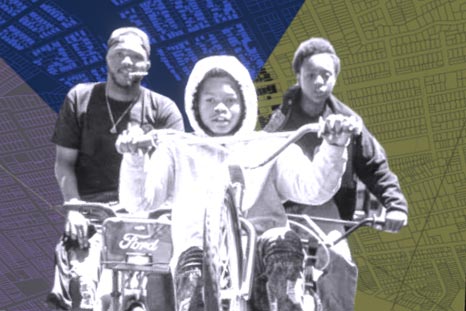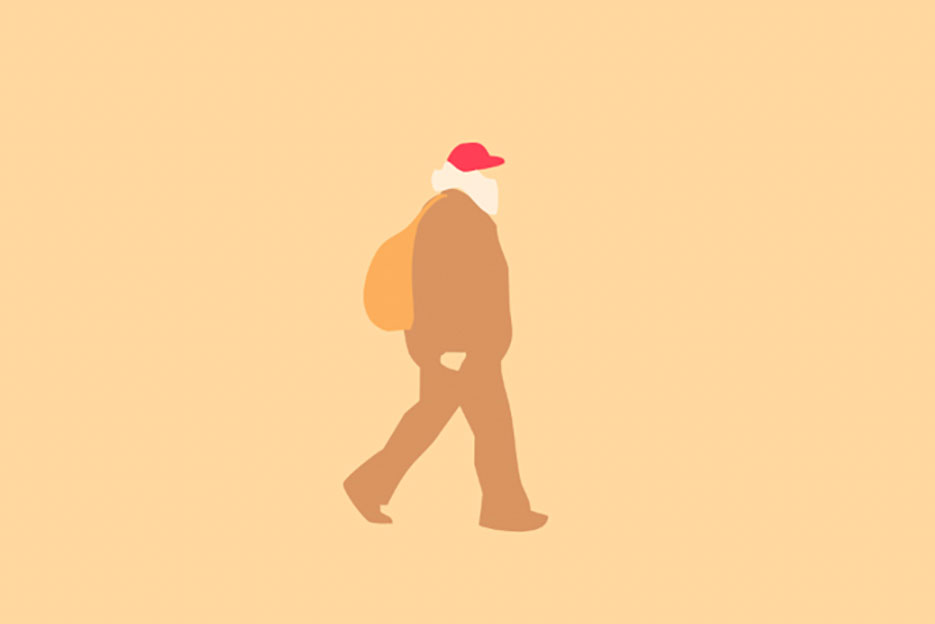Sun October 26th Open 11 AM–5 PM
Ceramics as a Form of Healing and Survival
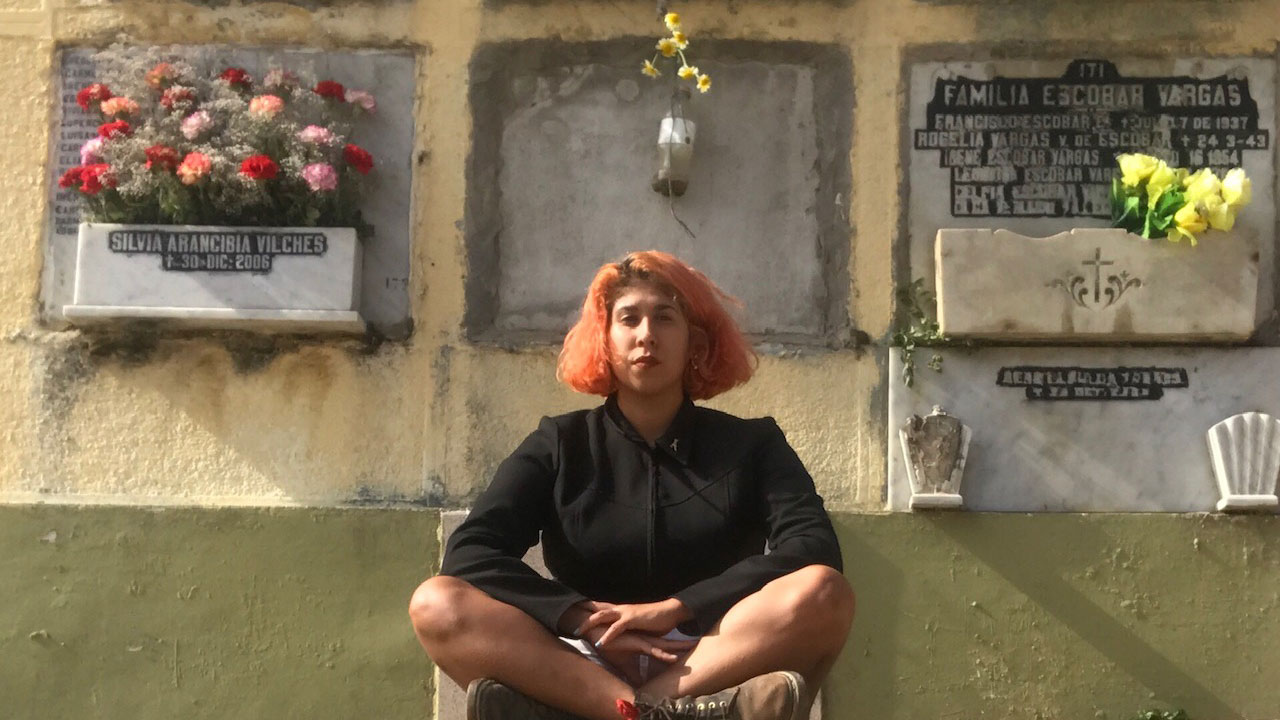
This article is part of the ongoing Come to Your Census: Who Counts in America? experience. This collaboration with Art+Action is part of their COME TO YOUR CENSUS campaign—powered by San Francisco’s Office of Civic Engagement and Immigrant Affairs (OCEIA)—which hopes to mobilize the public to take the 2020 U.S. Census. We want everyone to be counted and receive their fair share of funding and political representation for their community.
If you have not already done so, we highly encourage you to take the 2020 US Census.
Featured in YBCA’s art and civic experience Come to Your Census: Who Counts in America?, Maria Paz is a self-taught artist who uses ceramics to transform her memories into sculptural objects. These works pay tribute to her family and her Chilean ancestors through an homage to ceramic artifacts that also serve as objects of healing.
YBCA’s Director of Public Life Sarah Cathers had a video chat with Maria, on April 15, 2020 to talk about how the shelter in place orders have affected her relationship to her community, and how she uses symbols and storytelling to reflect on her personal history and intersectional identity.
The interview has been edited for clarity.
Sarah Cathers: Hi Maria, so good to be able to catch up with you today! I’ve heard that you had an unusual path to your arts education. Could you tell me a little bit about how you learned ceramics?
Maria Paz: My dad was a painter and when I was little he would tell me, “Just paint your feelings,” because as a kid I would throw a million tantrums. As a teen I got really into comic book illustration and wanted to expand my drawing abilities so I decided to take an arts course at College of the Desert in Palm Desert, where I grew up.
I was trying to take life drawing but the only course available was ceramic sculpture. I took that when I was 18 and just immediately fell in love. I eventually moved to San Francisco and enrolled in a ceramics course at SF City College’s Fort Mason arts campus. I met the head of the ceramics program, Oli Quezada, and he was so sweet and said to me, “Oh, I love your work and I love what you’re doing, you should take my class.” So I took his class and he was just so uplifting and so proud of me, even though he didn’t know me.
One day I asked him if I could start working as a tech. He said yes and gave me a volunteer position. I’ve been a volunteer in the ceramics program for 7 years now. So I’m a self-taught ceramic sculptor working at CCSF under someone who has a wealth of ceramic knowledge.
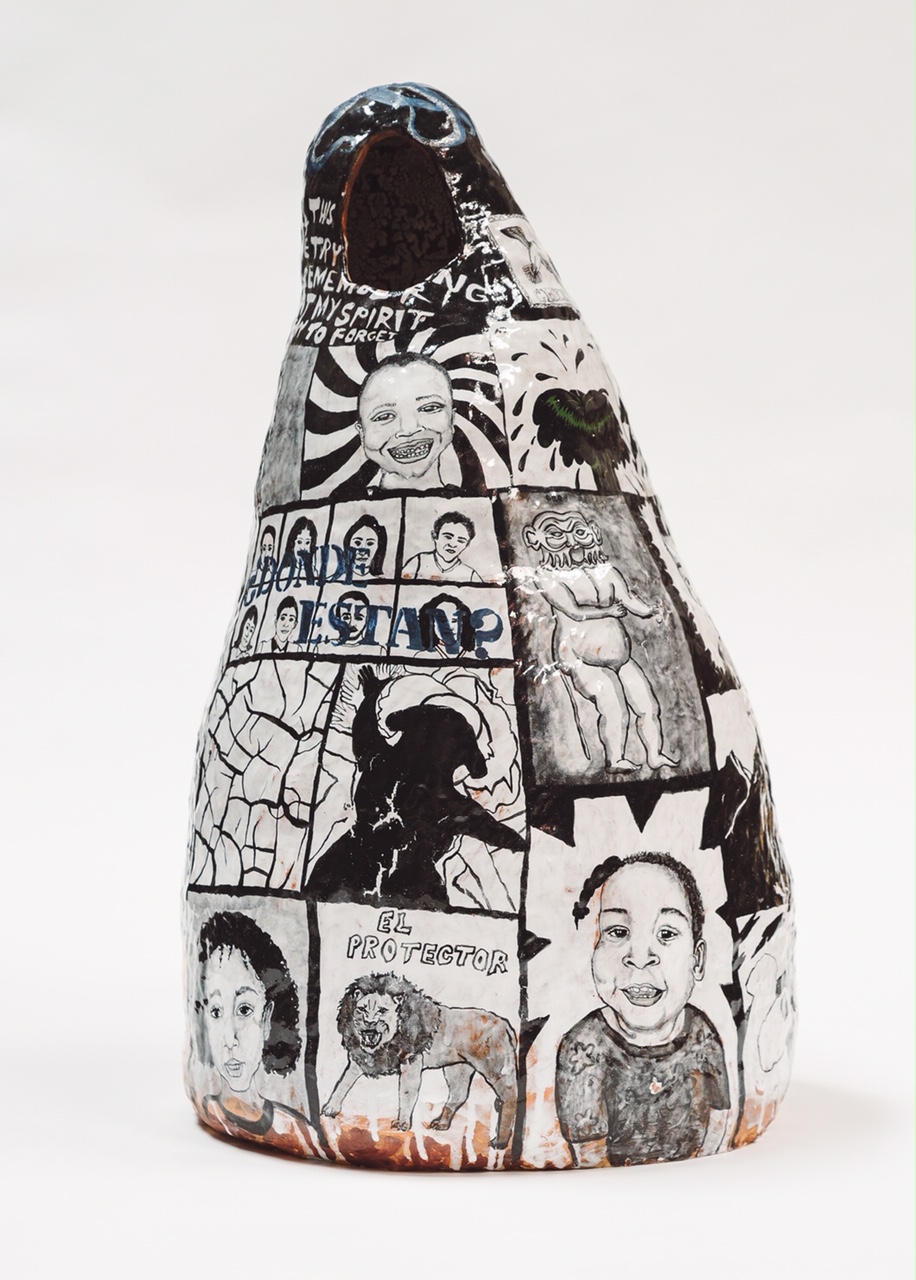
Stoneware, glaze. Courtesy of the artist.
SC: Why didn’t you go to college, or why did you choose not to go the full art school path?
MP: Honestly, I was undocumented so I didn’t see that as an option at the time. I also knew getting scholarships would be extremely difficult and because I’m an artist I figured I could just do it myself. But it wasn’t easy. I had to look for ways to learn in this super technical field. And that was why I was determined to learn everything you would learn in school, if not more, by just doing it. That has become a big part of my story. I think a lot of the looseness that I have within ceramics is because I wasn’t in an academic setting where I could have lost some of that.
SC: So it sounds like you intentionally chose to be self-taught whether you were undocumented or not. You just said, “okay. Well, here’s my path, I’m going to get there my way.”
MP: For sure. I chose it when I was 18 and was like, “This is what I’m going to do.” And when I got to San Francisco I just didn’t stop.
SC: What made you decide to move to San Francisco from Palm Desert?
MP: Two reasons: obviously the legacy of the arts in San Francisco, but also that San Francisco is a sanctuary city and I was undocumented. I wanted to go to a city where I felt much safer than where I was. SF also had public transportation, and at the time I couldn’t legally drive. So being in a place like Palm Desert was hard because the bus comes every hour and a half or something. To me San Francisco felt like this place where all kinds of beautiful people of different backgrounds were accepted. The LGBTQIA+ community, Black, Brown, Indigenous people and undocumented folks were all living amongst each other and fighting for each other. I wanted to be a part of that.
SC: Did you not drive because you couldn’t get a driver’s license due to being undocumented?
MP: Yeah, I couldn’t get one. After I had moved to San Francisco DACA passed and became an option for me, but I was really scared to put myself on a federal list, so I just didn’t do it.
SC: Thinking about being scared to be on a federal list, was it easy for you to make a connection why your work would be included in Come to Your Census? What went through your mind when we asked you to be part of this?
MP: I immediately looked up to see if the citizenship question was on the Census before responding, straight up. For me, being counted was really scary. Being put on a list was exactly what I tried to avoid growing up. I wanted to know, what is the census today? What does it look like? And if it has this question then, no I don’t want to be a part of that because I don’t think it’s fair for people to have to answer this question.
SC: With the question excluded from the census how do you feel about taking it now? Will you?
MP: I did take it. I think it’s so important. We need more funding and more representation for all of our communities. Everyone needs to be counted. We need to fight homelessness, we need more mental health institutions versus just putting people in jail and prisons, let’s get them help. The gender question really threw me off though. I identify as female, but so many of my friends don’t identify with the options the Census gives you, male and female.
So that was one thing that I was like, “okay, that needs work.” Also identifying as Latinx wasn’t an option and a lot of us don’t call ourselves Hispanic because it’s problematic. So I think there is still work to be done on it. I hope that in 10 years they can do that.
SC: Ok, so let’s get back to your narrative and artistic process. How did your style evolve over time into what it is today?
MP: Historically, ceramics has been an avenue for people to tell stories of their civilizations. At a certain point I started painting my story on clay. When I got my Green Card in the mail and I remember one of my friends asking me all these questions like, “oh my god. How does it feel? Do you feel safe, do you feel free, do you…?” I remember just being completely overwhelmed and not being able to answer any of them. That was when I thought, “okay. I need to just get this out.” That’s when I began storytelling on ceramics.
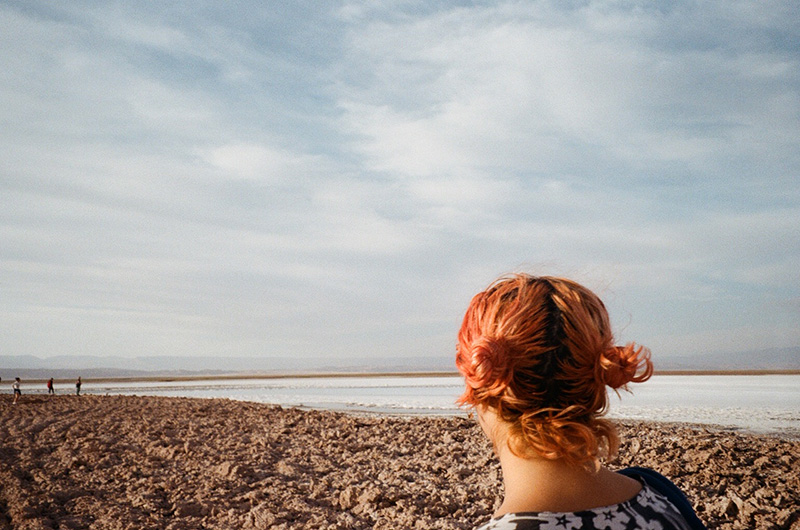
SC: As part of an earlier conversation we had, you talked about converting memories and feelings to symbols. When did you start learning how to do that? How did that become part of your storytelling?
MP: I think the first time that happened was… I made this piece called El Guanaco. I showed it to Marcela Pardo Ariza, a great friend of mine, who included it in this incredible show at Southern Exposure she curated. That piece was about making sense of Chile, the country that I was born in that I couldn’t visit. I left Chile at nine months old. So I’ve been in the United States a long time and I couldn’t go back. All these different things that made up my social location, at the time I didn’t have this language to identify this, but I was trying to figure it out by painting on clay. I made this bottle and painted so many things on it–like when my grandma passed away when I was five and the ripple effect that had on my life. That’s when I started using symbols. I started painting Chilean food and anything that could bring me closer.
MP: There’s empanadas, pan con palta, pisco… There’s all these different little emblems of Chile and Chilean culture on that piece. It’s called El Guanaco, after the llama family that lives all over Chile. That was when I realized how painting these symbols had a really big impact on my healing and my survival. I saw painting on clay as my resistance. I did so much research on Chile. I just sat there and thought about Chile for about 30 hours. Painting this thing and erasing things and going back. That was the beginning of my current practice.
SC: How does the concept of healing relate to your artwork or exist in your practice? Do you consider healing political?
MP: I think healing and empowerment are at the center of my practice. I’ve dedicated the past six years of my life to healing and I think that is political engagement because telling my story and my ancestors stories is an act of resistance. But I don’t think I necessarily have a choice to be political or not. I was born into a family who migrated because of a dictatorship. My story is political but it’s also just me. Painting my story is the only way that I know how to heal and make sense of all of these different parts of my intersectional identity.
SC: One of the things that Martin and I really saw in your work, and in a lot of the artists that are included in the exhibit, is that you are all individual voices that tell very distinct stories, but are very much a part of the larger community. I wonder, how do you see yourself in relation to community, how do you engage in your community and the social structures around you? Is it through your work or through yourself as an individual?
MP: I think both. Certainly through my work and through my personal relationships. I’m in Oakland and the rate of gentrification here is wild. I want to be really intentional about moving into a neighborhood and what I can bring to that space. If I’m taking up space where someone was before me, then I want to intentionally give back to the people around me.
My neighbors in Oakland are a bunch of families, and they are specifically who I’m talking about in terms of community. They are beautiful and I’ve gotten to know these kids and their parents. On the surface they don’t have a lot, but the amount of love and joy that they have for each other and the world is the most inspiring and healing thing.
I think growing up in the U.S. as an immigrant here, I only had my nuclear family. Most of my family was still in Chile. We became very American in that way. It was just us. But when I’m in Oakland that is not how it is. Grandma is there, Grandpa, cousins, sisters, brother… Everyone’s there and they’re all together and they all help each other and they all hold each other. They’re all like, “Cool. I’ll take care of your kids, I’ll feed them. Don’t even ask, just drop them off whenever.”
When I started spending lots of time with them, they said, “You’re part of the family.” I go over to my neighbor’s homes all the time and hang out, we take the kids to the river, we go to the movies, we go out to eat, we get ice cream. I got the parents a gift card to go to a restaurant for their anniversary and then they invited me to join them!
Community is not necessarily giving back monetarily, but rather building relationships with the people that surround you. I moved to Oakland from San Francisco and I was like, “Well, I’m not just going to sit here and be someone who just takes up space.”

SC: We’re conducting this interview from the middle of a pandemic, in which we’re told to shelter in place and stay at home so that sense of community is really being challenged right now. What’s at stake for you and your family-neighbor-friends? Are you able to be with them right now? How are you connecting with everyone?
MP: It’s been really difficult not being able to support the families just by taking their kids off their hands, especially now that the kids are out of school and going crazy. But there are other ways that we can support one another– we talk on the phone or sometimes I just yell out my window and talk to them.
SC: The census was not top of mind for me before we began working with Amy Kisch of Art+Action and doesn’t seem to be top of mind for most people. But I can’t stop thinking about the way that our federal government is reacting, our state government, our local government, and how important it is to get funds tied to the census for each person.
Do you think your community, your neighbors are going to take the census? Do you talk to them about that?
MP: Right now some of my neighbors are struggling financially and I don’t think they realize that there is help available to them because we live in a country where that is not voiced. Our country does not explicitly say, “We are here to support you through this hard time” especially to black, brown and native communities.
Recognizing that the census is how we get funding for underrepresented communities and for minorities is so important. This is where resource money comes from, from every person that’s counted.
I want the kids to go to better schools, I want them to get a better education. I want their school food to not be so unhealthy. And that comes from the census.
I want all of us to have access to more affordable healthcare. That’s all definitely on my mind a lot right now. So many of us are struggling and if we had more access and more funding for these different programs that are literally built to support our communities then we would be in a better place right now.
SC: So here’s my last question. What is the first thing you’re going to do when shelter in place is over?
MP: Oh, that’s such a good question. I want my friends. I want my community. I want us all together and I want us to make food and share it and grab it and eat it with our hands. I just want to be held and hold others physically.

